

The Future Of Buildings Is Powering Them By Green Gunk. Algae "bioreactors" absorb carbon dioxide, while producing oxygen, heat, and several types of biomass, including material that can be turned into fuel or food.

That's why they're potentially very useful for cities that need heat and calories, and that want to cut down on pollution. We've seen before how this can work: Most of this Hamburg building was powered by large algae panels clad to its outside. (Yes, it really worked). Now comes another prototype: the "Urban Algae Folly," from U.K. -based designers Marco Poletto and Claudia Pasquero. Built for the "Future Food District" at the ongoing Milan Expo, the canopy is made of metal sections welded together with transparent tubes and pipes carrying a mixture of water, CO2, and nutrients.
The "Folly"—a building made for decorative or whimsical purposes—contains a series of motion-sensors inside. "The folly produces the equivalent oxygen for three adults to survive. Heating houses with 'nerd power' - BBC News. Image copyright ALAMY All computers produce heat, but computer servers produce a lot of heat - so much that it usually costs a fortune to cool them down.
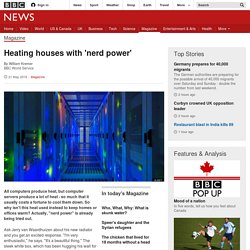
So why isn't this heat used instead to keep homes or offices warm? Actually, "nerd power" is already being tried out. Ask Jerry van Waardhuizen about his new radiator and you get an excited response. "I'm very enthusiastic," he says. Instead of hot water, it contains a computer connected to the internet, doing big sums and kicking out heat in the process.
We talk about data being "virtual" and stored on a "cloud". Image copyright Jerry van Waardhuizen Nerdalize's solution is, effectively, to spread their data centre across domestic homes linked by fibre-optic cable. The radiators take a little longer than average to heat up - about an hour, Waardhuizen says - and a single unit won't be enough to heat a room in mid-winter.
Waste-to-energy. Waste-to-energy or energy-from-waste is the process of generating energy in the form of electricity and/or heat from the incineration of waste.

WtE is a form of energy recovery. Most WtE processes produce electricity and/or heat directly through combustion, or produce a combustible fuel commodity, such as methane, methanol, ethanol or synthetic fuels.[1] History[edit] The first incinerator or 'Destructor' was built in Nottingham UK in 1874 by Manlove, Alliott & Co. Ltd. to the design of Albert Fryer.[2] The first US incinerator was built in 1885 on Governors Island in New York, NY.[3] Tri generation. Sustainable energy. Sustainable energy is the sustainable provision of sustainable energy development that meets the needs of the present without compromising the ability of future generations to meet their needs.
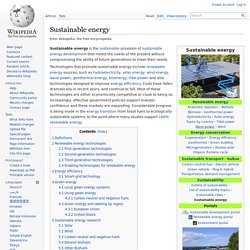
Technologies that promote sustainable energy include renewable energy sources, such as hydroelectricity, solar energy, wind energy, wave power, geothermal energy, bioenergy, tidal power and also technologies designed to improve energy efficiency. Costs have fallen dramatically in recent years, and continue to fall. Most of these technologies are either economically competitive or close to being so. Increasingly, effective government policies support investor confidence and these markets are expanding. Considerable progress is being made in the energy transition from fossil fuels to ecologically sustainable systems, to the point where many studies support 100% renewable energy. Definitions[edit] Nationwide gas grid starts to emerge as NSW and NT sign $1bn pipeline deal. Australia is one step closer to establishing a national gas grid after New South Wales and the Northern Territory formally endorsed a proposed pipeline.
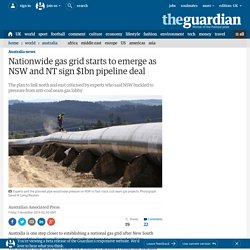
The planned link would run from Alice Springs to Moomba connecting northern and eastern gas markets. Energy experts said it would ease pressure on NSW to fast-track controversial coal seam gas (CSG) projects as the state approaches an expected gas shortage in the next few years. The premier of NSW, Mike Baird, and the NT’s chief minister, Adam Giles, signed a memorandum of understanding in Sydney on Friday.
But the plan has already been criticised by energy experts who said the NSW government had buckled to pressure from the anti-CSG lobby. Geoffrey Cann, the national director of oil and gas at Deloitte, said NSW had an ample supply of gas and should be working towards extracting it rather than relying on other states. The project is expected to cost between $900m and $1.3bn and is hoped to be operational by mid-2018. Waste Authority WA. This WtE Position Statement complements the Section 16e advice and presents additional matters of interest for the Authority that are outside the scope of that advice.
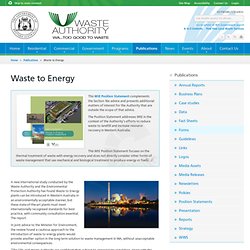
The Position Statement addresses WtE in the context of the Authority’s efforts to reduce waste to landfill and increase resource recovery in Western Australia. This WtE Position Statement focuses on the thermal treatment of waste with energy recovery and does not directly consider other forms of waste management that use mechanical and biological treatment to produce energy or fuels. A new international study conducted by the Waste Authority and the Environmental Protection Authority has found Waste to Energy plants can be introduced in Western Australia in an environmentally acceptable manner, but these state-of-the-art plants must meet internationally recognised standards for best practice, with community consultation essential.
The report The advice makes 21 recommendations based on six key principles: Elektromotive. Elektromotive is a UK based company specialising in the manufacture and installation of charging infrastructure for electric cars and other electric vehicles, using their trade name of Elektrobay.[1][2] The company has partnerships with major corporations including EDF Energy[3] and Mercedes-Benz[4] to supply charging posts and data services.
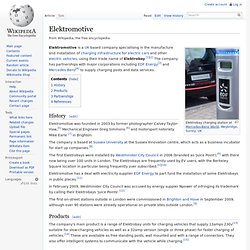
History[edit] Elektromotive was founded in 2003 by former photographer Calvey Taylor-Haw,[5] Mechanical Engineer Greg Simmons [6] and motorsport notoriety Mike Earle [7] in Brighton. The company is based at Sussex University at the Sussex Innovation centre, which acts as a business incubator for start up companies.[8] The first Elektrobays were installed by Westminster City Council in 2006 (branded as 'Juice Point'),[9] with there now being over 100 units in London. The Elektrobays are frequently used by EV users, with the Berkeley Square location in particular being frequently over subscribed.[5][10] Products[edit] Partnerships[edit] References[edit]
Home - NSW Resources and Energy. Projects - Garden Island, Western Australia. This project will be the first demonstration of a complete grid-connected, commercial scale CETO system anywhere in the world.
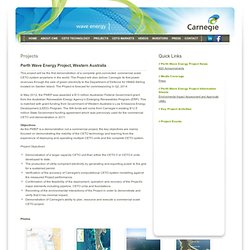
The Project will also deliver Carnegie its first power revenues through the sale of green electricity to the Department of Defence for HMAS Stirling located on Garden Island. The Project is forecast for commissioning in Q2, 2014 In May 2012, the PWEP was awarded a $13 million Australian Federal Government grant from the Australian Renewable Energy Agency’s Emerging Renewables Program (ERP). This is matched with grant funding from Government of Western Australia’s Low Emissions Energy Development (LEED) Program. The WA funds will come from Carnegie’s existing $12.5 million State Government funding agreement which was previously used for the commercial CETO unit demonstration in 2011. Objectives Project Objectives Demonstration of a larger capacity CETO unit than either the CETO 3 or CETO 4 units developed to date.
Photos. Energy in Australia. Total employment in the electricity-supply industry (thousands of people) since 1984 Energy in Australia includes energy and electricity production, consumption and export in Australia.
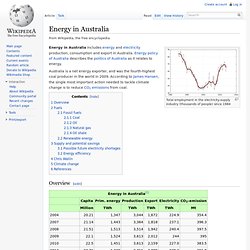
Energy policy of Australia describes the politics of Australia as it relates to energy. Australia is a net energy exporter, and was the fourth-highest coal producer in the world in 2009. According to James Hansen, the single most important action needed to tackle climate change is to reduce CO2 emissions from coal. Secure, Clean and Efficient Energy. To make the transition to a competitive energy system, we need to overcome a number of challenges, such as increasingly scarce resources, growing energy needs and climate change.

The Energy Challenge is structured around seven specific objectives and research areas: Reducing energy consumption and carbon footprintLow-cost, low-carbon electricity supplyAlternative fuels and mobile energy sourcesA single, smart European electricity gridNew knowledge and technologiesRobust decision making and public engagementMarket uptake of energy and ICT innovation. A budget of €5 931 million has been allocated to non-nuclear energy research for the period 2014-2020. Out of this figure, more than €200 million is earmarked to support European Institute of Innovation and Technology activities, subject to a mid-term review. Main priorities The first work programme for "Secure, Clean and Efficient Energy" will be split into the following focus areas: Renewable energy. Renewable energy is generally defined as energy that comes from resources which are naturally replenished on a human timescale such as sunlight, wind, rain, tides, waves and geothermal heat.[2] Renewable energy replaces conventional fuels in four distinct areas: electricity generation, hot water/space heating, motor fuels, and rural (off-grid) energy services.[3] About 16% of global final energy consumption presently comes from renewable resources, with 10% [4] of all energy from traditional biomass, mainly used for heating, and 3.4% from hydroelectricity.
New renewables (small hydro, modern biomass, wind, solar, geothermal, and biofuels) account for another 3% and are growing rapidly.[5] At the national level, at least 30 nations around the world already have renewable energy contributing more than 20% of energy supply. Carbon-taxed companies cut emissions by 7% in past year, investor group says. Greenhouse emissions from Australian companies paying the carbon tax have fallen by 7% over the past year “in large part” due to the carbon price impost, the Investor Group on Climate Change has said. Calculations by the group of official data from the Clean Energy Regulator shows carbon emissions from Australia’s 350 largest corporate emitters – who are directly liable to pay the tax – fell from 342m tonnes in 2011-12 to 321m tonnes in 2012-13.
The group’s chief executive, Nathan Fabian, said he believed the carbon tax was “the major contributor” to the decrease in emissions, although other factors did play a role, including the shutdown of some large electricity generators because of weather events and the closure of some major manufacturing operations. Fabian’s group represents institutional and other investors interested in the impact of climate change on investments. “We think banks will take a similar view,” he told a Senate committee inquiry into the Direct Action scheme. Renewable energy in Germany. Biogas fermenter, wind turbine and photovoltaics on a farm in Horstedt, Schleswig-Holstein Renewable electric power produced in 2011 by energy source Germany's renewable energy sector is among the most innovative and successful worldwide.
Nordex , Repower , Fuhrländer and Enercon are wind power companies based in Germany. Solon SE , Q-Cells and Conergy are solar power companies based in Germany. These companies dominate the world market. In 2012, the use of variable renewable energy is, according to the German newspaper Der Spiegel , causing increasing electricity prices and grid instability induced power outages . [ 9 ] However, based on official statistics for the period between 2007 and 2012, electricity prices for industrial consumers in Germany were decreased from €94.6 to €89.5 per MWh. [ 10 ] Renewable energy in Australia. Australian renewable power plants. Energy in Australia. How American energy independence could change the world. If the bookies are to be believed, Chelsea Clinton could turn out to be luckiest US president in history. The holy grail of American leaders over the past four decades, from Richard Nixon to Barack Obama, has been energy independence, and thanks to shale oil and gas, the dream could soon become reality.
The International Energy Agency (IEA) and oil giant BP certainly think so - they believe the US will be energy independent by 2035. Energy storage: The key to a smarter power grid. 23 April 2014Last updated at 19:16 ET By Richard Anderson Business reporter, BBC News Demand for electricity is set to soar due to efforts to reduce CO2 emissions. Funds target low emission energy projects. Environment - Digital Agenda for Europe. Energy germany. Renewable energy in Australia.